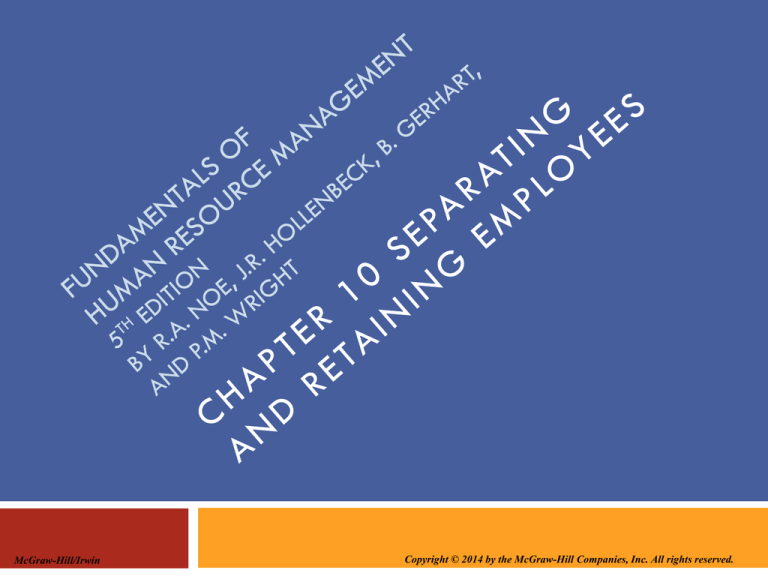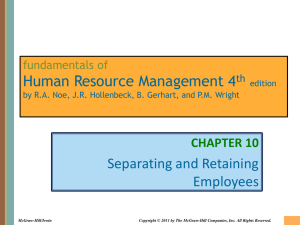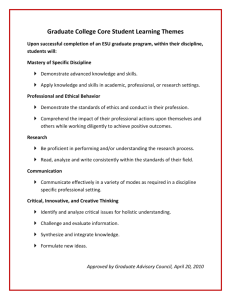
McGraw-Hill/Irwin
Copyright © 2014 by the McGraw-Hill Companies, Inc. All rights reserved.
Need to Know
1.
2.
3.
4.
5.
6.
Difference between involuntary and voluntary
turnover, and their effects on an organization.
How employees determine whether the
organization treats them fairly.
Legal requirements for employee discipline.
Ways to fairly discipline employees.
How dissatisfaction affects employee behavior.
How organizations contribute to employees’ job
satisfaction and retain key employees.
10-2
Introduction
•
•
•
•
Every organization recognizes that it needs satisfied,
loyal customers.
In addition, success requires satisfied, loyal
employees.
Retaining employees helps retain customers and
increase sales.
Organizations with low turnover and satisfied
employees tend to perform better.
10-3
Managing Turnover
What was the primary reason you’ve ever quit a
job?
a)
b)
c)
d)
e)
f)
I Didn’t like my boss or coworkers
I wasn’t a fit with the company culture
Better pay somewhere else
More interesting or challenging work somewhere
else
I was fired or laid off
Other
10-4
Managing Voluntary and
Involuntary Turnover
Involuntary Turnover
Voluntary Turnover
Turnover initiated by an
•Turnover initiated by
employer.
employees.
•Often with employees who
•Often when the
would prefer to stay.
organization would prefer
to keep them.
•
10-5
Table 10.1: Costs Associated with Turnover
10-6
Test Your Knowledge
1.
2.
True (A) or False (B)
A manager who decides to fire an employee
should quietly take action alone and then let
others know afterwards.
Separating employees has financial and personal
risks.
10-7
Employee Separation
•
•
•
•
Organizations must develop a standardized,
systematic approach to discipline and discharge.
These decisions should not be left solely to the
discretion of individual managers or supervisors.
Policies should be based on principles of justice and
law.
Policies should allow for various ways to intervene.
10-8
Principles of Justice
• A judgment
that the
consequences
given to
employees are
just.
• A judgment
that fair
methods were
used to
determine the
consequences
an employee
receives.
• A judgment
that the
organization
carried out its
actions in a
way that took
the employee’s
feelings into
account.
10-9
Figure 10.1: Principles of Justice
10-10
Test Your Knowledge
A company whose earnings are very low has to reduce
the amount given in raises to avoid laying people off.
The amount of the raise for each employee is
determined objectively based on their performance.
An employee working for this company will most likely
feel ____________ and _________________.
a)
b)
c)
d)
High outcome fairness; high interactional injustice
Low outcome fairness; high procedural justice
Low interactional justice, high outcome fairness
Low outcome fairness, low procedural justice
10-11
Legal Requirements
Wrongful Discharge
Discrimination
Discharge may not violate
an implied agreement.
•
•
–
–
e.g., employer had
promised job security
e.g. action inconsistent
with company rules
Discharge may not violate
public policy.
•
–
e.g., terminating
employee for refusing to
do something illegal or
unsafe.
•
Employers must make
discipline decisions
without regard to a
person’s age, sex, race,
or other protected
status.
Evenhanded, carefully
documented discipline
can avoid such claims.
10-12
Legal Requirements
•
•
•
Employees’ Privacy:
Employers need to ensure that the information
they gather and use for discipline is relevant.
Privacy issues also concern the employer’s wish to
search or monitor employees.
Employers must be prudent in deciding who will
see the information.
10-13
Table 10.2: Measures for Protecting Employees’
Privacy
10-14
Test Your Knowledge
Pam Jones worked for 41 years at the same company and
had positive performance ratings and personnel records.
She needed a calculator for work which she purchased with
her own money but was not reimbursed because she lost
the receipt. Later, a security guard stopped her as she was
leaving work and discovered the calculator in her
belongings. After a brief internal investigation, she was
fired and it was announced through internal notices that
she had committed a theft. The employee sued for libel,
saying the company used her as an example to prevent
other thefts.
10-15
Legal Requirements
•
•
Notification of Layoffs:
Organizations that plan broad-scale layoffs may be
subject to the Workers’ Adjustment, Retraining
and Notification Act (WARN).
Employers covered by the law are required to give
notice before any closing or layoff.
10-16
Test Your Knowledge
After hiring Bob for a newly created marketing
specialist position, his boss assures him that he will
be secure in the job until he retires. A year later,
that department is eliminated. Bob complains he
was guaranteed employment until retirement. Is
he right?
a)
b)
c)
No, an employer can hire or fire someone whenever
they want.
No, there was no written contract.
Yes, he was given a verbal contract.
10-17
Progressive Discipline
Hot-Stove Rule
Principle of discipline that
says discipline should be
like a hot stove, giving
clear warning and
following up with
consistent, objective, and
immediate consequences.
•
Progressive Discipline
A formal discipline process
in which the consequences
become more serious if the
employee repeats the
offense.
•
10-18
Figure 10.2: Progressive Discipline Responses
10-19
Progressive Discipline
Rules of behavior should
cover disciplinary
problems such as:
•Tardiness
•Absenteeism
•Unsafe work practices
•Poor quantity or quality
of work
•Sexual harassment
•
•
•
Coming to work
impaired by alcohol or
drugs
Theft of company
property
Cyberslacking
10-20
Guidelines to Respond to Misconduct
1.
2.
3.
4.
5.
6.
7.
8.
Be clear about performance standards.
Be consistent.
Don’t ignore the problem behavior.
Investigate complaints ASAP.
Record statements in writing, with signatures &
dates.
Focus on behaviors not personalities
Documentation should be clear and complete.
Be honest.
10-21
Figure 10.3: Options for Alternative
Dispute Resolution
10-22
Alternative Dispute Resolution
Open-Door Policy
Peer Review
An organization’s policy
of making managers
available to hear
complaints.
•
Process for resolving
disputes by taking them to
a panel composed of
representatives from the
organization at same
levels as the people in the
dispute.
10-23
Alternative Dispute Resolution
Mediation
Nonbinding process in
which a neutral party from
outside the organization
hears the case and tries to
help the people in a
conflict arrive at a
settlement.
•
Arbitration
Binding process in which a
professional arbitrator
from outside the
organization (usually a
lawyer or judge) hears the
case and resolves it by
making a decision.
•
10-24
Employee Assistance Programs
•
Employee assistance program (EAP) – a referral
service that employees can use to seek professional
treatment for emotional problems or substance
abuse.
Many EAPs are fully integrated into employers’
overall health benefits plans.
10-25
Outplacement Counseling
•
Outplacement counseling – a service in which
professionals try to help dismissed employees
manage the transition from one job to another.
Goals for outplacement counseling are to help
former employee address psychological issues
associated with losing a job while helping them find
a new job.
10-26
Job Withdrawal
•
Job Withdrawal – a set of behaviors with which
employees try to avoid the work situation
physically, mentally, or emotionally.
Job withdrawal results when circumstances such as
the nature of the job, supervisors and coworkers,
pay levels, or the employee’s own disposition
cause the employee to become dissatisfied with
the job.
10-27
Employee Engagement
Employee engagement is the degree to which
employees are fully involved in their work and the
strength of their commitment to their job and company.
•Employees who are engaged and provide a clear
competitive advantage to that firm, including higher
productivity, better customer service, and lower
turnover.
10-28
Figure 10.4: Job Withdrawal Process
10-29
Causes of Job Dissatisfaction
Personal
Dispositions
Tasks and Roles
Supervisors &
Coworkers
Pay and Benefits
• Negative affectivity
• Core self-evaluations
• Role
• Role ambiguity
• Role conflict
• Role overload
• Negative behavior by managers
• Conflicts between employees
• Pay is an indicator of status .
• Pay & benefits contribute to self-worth
10-30
Military reservists who
are sent overseas often
experience role conflict
among three roles:
soldier
• family member
• civilian employee
Overseas assignments
often intensify role
conflicts.
•
10-31
Actions Employees Take When Dissatisfied
•
Behavior changes
–
–
–
–
•
•
Change the condition
Whistle-blowing
Bring a lawsuit
Lodge complaints
Physical job withdrawal
Psychological withdrawal
–
–
Decrease in job involvement
Decrease in organizational commitment
10-32
Office Workers Appreciate Help Balancing Roles
and Learning New Skills
10-33
Job Satisfaction
Job satisfaction – a pleasant feeling resulting from
the perception that one’s job fulfills or allows for
the fulfillment of one’s important job values.
3 components of job satisfaction are:
1.
2.
3.
Values
Perceptions
Ideas of what is important
People will be satisfied with their jobs as long as
they perceive that their jobs meet their important
values.
10-34
Figure 10.5: Increasing Job Satisfaction
10-35
Figure 10.6 Steps in
the Role Analysis
Technique
10-36
Job Satisfaction:
Supervisors and Co-workers
Co-workers and supervisors affect job satisfaction.
•
1.
2.
3.
A person may be satisfied with them because they
share same values, attitudes, and philosophies.
provide social support, meaning they are sympathetic
and caring.
help the person attain some valued outcome.
10-37
Co-worker relationships can contribute to job
satisfaction, and organizations therefore try
to provide opportunities to build positive
relationships.
10-38
Test Your Knowledge
•
Serena feels her job processing payroll checks is
boring and uninteresting. Which intervention would
be most appropriate to retain Serena?
a)
b)
c)
d)
Communicating the companies values
Increasing her pay
Expanding her job
Hiring someone she can chat with during the day
10-39
Monitoring Job Satisfaction
•
•
•
Employers can better retain employees if they are
aware of satisfaction levels, so they can make
changes if employees are dissatisfied.
Usual way to measure job satisfaction is to survey.
A systematic, ongoing program of employee
surveys should be part of the organization’s HR
strategy to monitor trends and prevent voluntary
turnover.
10-40
Figure 10.7: Example of Job Descriptive Index
(JDI)
10-41
Figure 10.8: Example of a Simplified, Nonverbal
Measure of Job Satisfaction
10-42
Exit Interview
•
•
•
Exit interview: a meeting of a departing
employee with the employee’s supervisor
and/or a human resource specialist to discuss
the employee’s reasons for leaving.
A well-conducted exit interview can uncover
reasons why employees leave.
When several exiting employees give similar
reasons for leaving, management should
consider whether this indicates a need for
change.
10-43
Summary
•
•
Involuntary turnover occurs when the organization
requires employees to leave, often when they would
prefer to stay.
Voluntary turnover occurs when employees initiate
the turnover, often when the organization would
prefer to keep them.
10-44
Summary
•
•
•
Employees draw conclusions based on outcomes of
decisions regarding them, procedures applied, and
way managers treat employees when carrying out
those procedures.
Employee discipline should not result in wrongful
discharge, such as a termination that violates an
implied contract or public policy.
Discipline should be administered evenhandedly,
without discrimination.
10-45
Summary
•
•
•
Discipline should follow principles of the hot-stove
rule, meaning discipline should give warning and
have consequences that are consistent, objective,
and immediate.
A system that can meet these requirements is
progressive discipline, in which rules are established
and communicated, and increasingly severe
consequences follow each violation of the rules.
Organizations may also resolve problems through
alternative dispute resolution.
10-46
Summary
•
•
Circumstances involving the nature of a job,
supervisors and coworkers, pay levels, or
employee’s own disposition may produce job
dissatisfaction. When employees become
dissatisfied, they may engage in job withdrawal.
To prevent job withdrawal, organizations need to
promote job satisfaction which is related to a
person’s values and based on perception.
Different employees have
different views of which values
are important.
10-47







